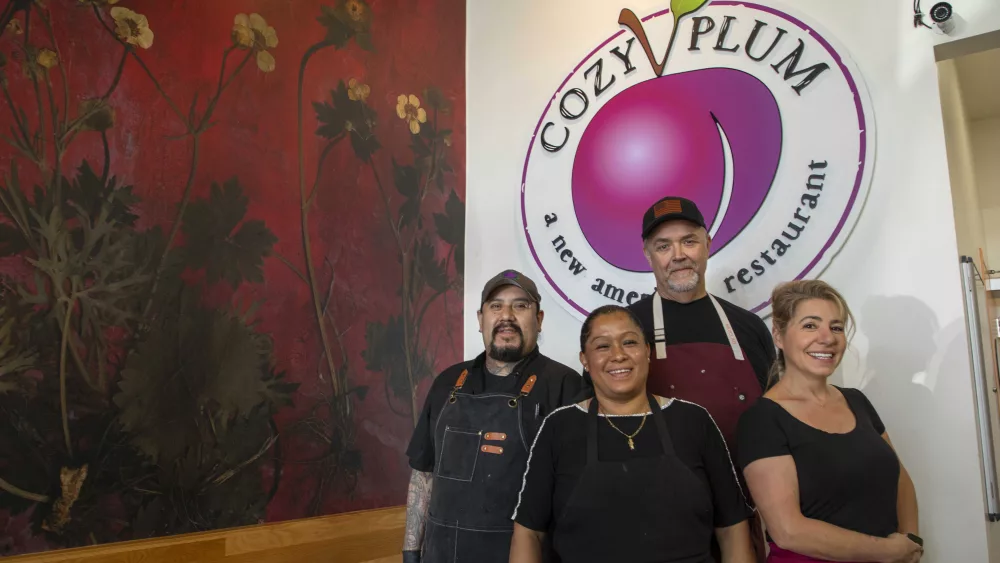Santa Rosa’s once-forgotten SOFA (South of A Street) district is growing strong, thanks to an influx of artists, eclectic businesses and events.
Looking back 100 years, the neighborhood just south of Santa Rosa’s Julliard Park (South A Street to Sebastopol Ave.) was a thriving, bustling crossroads. But over time, it lost its luster, beginning when Highway 101 moved in right next door. The area fell into decline and only a few business remained until the 1990s, when an infusion of artists began to move in—and planted the seeds of transformation.
Some of the first were a group who set up shop at a building they called A Street Studios and Gallery. “Kathleen Thompson took on the abandoned building in 1992,” says Andrea Speer Hibbard, an illustrator and painter who moved to Santa Rosa from Los Angeles in the 1980s. “Then Steve Milton took it on. It was like a David Lynch movie in there. They lived in a trailer inside the building, with a few petrified cats on a window ledge and Boris, the meanest pig ever. It was bizarre, hilarious and wonderful. When they bought a house and moved in the late 1990s, they asked me to take over.”
Speer Hibbard renovated the building with the help of “people who were rehabbing themselves; kids at risk, NA members. People thought I was crazy.” But the result was anything but that, and artists soon filled the affordable studios where they could work happily and support one another. In between curated art exhibits, they hosted film festivals, music, dance and drama performances. “When people came to us looking for space to hold their event, we fit them in,” she says.
In 1999, glass artist Laurence (who goes by one name) was looking for a studio and was sent to Speer Hibbard by a mutual friend. Laurence, who’s owned Laurence Glass Works in Occidental for 28 years, is a self-taught artist originally from France. “I was sharing a house with someone who gave me a toolbox of stuff and one of the things inside was a glass cutter. It was love at first sight,” she says of her original inspiration.
“A Street Studios and Gallery was like going to college. It had all the fun and creativity without boundaries. It was an education being around all the different personalities working on their art in the building and participating in the rotating exhibits,” she continues.
“It came together naturally,” adds Speer Hibbard. “It was like we had a clubhouse. I kept the rents cheap because I didn’t want a revolving door.”
“The neighborhood was really quiet during the day,” says Laurence. “There was a cook house across the street, a Russian cobbler, a steam bath owner who’d wander up and down the street, drunks in the alleyway. The park was a bit scary, filled with colorful people. Kids were afraid to play there. But we never got broken into, and people watched out for each other.”
“It had a circus vibe to it,” says Speer Hibbard. “It was loud at night, and I’d find empty liquor bottles outside in the mornings.”
“I’d hear some odd noises at night,” adds Don Bishop (D.A. Bishop), a realist painter who now works out of a studio in Sebastopol but whose work can be seen in several North Bay galleries and occasionally as a guest artist at SOFA events. “There was a lot of unwanted graffiti. The law office that’s now across the street from The Spinster Sisters [restaurant] was an auto detail place. There was a lawnmower repair shop, an upholstery shop, a barber shop and some empty spaces. The Naked Pig [a newer restaurant along Santa Rosa Avenue, at the east end of the neighborhood] was a Greyhound bus stop.
“Things started to change in 2000 or 2001, when the radiator shop became an art space.”
“It was a neighborhood that needed reclaiming,” says Laurence. “It’s Luther Burbank’s backyard. When [the area] started to blossom, families began moving in because it was affordable. It grew into a community naturally.”
“It’s a testimony to a cluster of creativity,” says Speer Hibbard. “It extends out and draws people. It’s the energy. I love the area’s regeneration, but it needs to stay affordable. Young artists can get priced out and go elsewhere.”
A Street Studios and Gallery was red-tagged as unusable by the city several years ago, and artists like Bishop, Laurence and Speer Hibbard (who also works out of a studio in Sebastopol) were forced to find new places to do their work. Yet they still embrace the time they had in the area. “It was a mess for us,” she concedes of the eviction, “but it was a change for the better for the building and the area.”
“I recently went to A Street and saw there was a wedding going on in Julliard Park. I almost cried,” says Speer Hibbard. “It’s really transformed. There are concerts and events, bocce ball and even a kids’ playground now.”
“My memories are full of love,” says Laurence.
A new artists’ Renaissance
Today, the neighborhood is bustling with energy and enthusiasm. You can literally feel the creativity and happiness in the air. New businesses are moving in and thriving and artists both new and old to the neighborhood are on the scene. Just walking around, you’ll see painted signs, murals, sculpture, decorated posts and more.
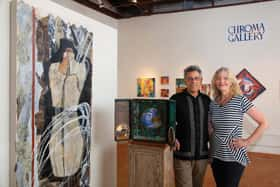 The re-rehabilitated building that was once A Street Studios and Gallery now houses Chroma Gallery, as well as eight other artists’ studios and galleries. “Arts are pivotal to the economic growth in Sonoma County,” says Simmon Factor, who owns Chroma Gallery with his wife, Robin. Both are working artists (Simmon paints and creates mixed-media art, while Robin describes her paintings as “visionary surrealist”) who previously owned and operated Village Art Supply in Montgomery Village until they sold it in 2012.
The re-rehabilitated building that was once A Street Studios and Gallery now houses Chroma Gallery, as well as eight other artists’ studios and galleries. “Arts are pivotal to the economic growth in Sonoma County,” says Simmon Factor, who owns Chroma Gallery with his wife, Robin. Both are working artists (Simmon paints and creates mixed-media art, while Robin describes her paintings as “visionary surrealist”) who previously owned and operated Village Art Supply in Montgomery Village until they sold it in 2012.
“This building is the nucleus around which this community grew,” he continues. “The property owners are great supporters of the arts and have kept the rents affordable.”
“Artists will colonize a marginal area and fix it up,” adds Robin. There are now 30 artist studios in the SOFA neighborhood, the highest concentration in Sonoma County. “We’re a community gallery,” she says. “Most shows are group shows based on a theme. The current one is ‘Like Nothing Seen Before: Collage and Assemblage Today’ [also known as shadow boxes].”
The couple has been working to fix up the building’s façcade as well as its backyard garden, where there’s a stage for regular free music performances in the warmer months. “The community needed a gathering place,” says Simmon of the patio. Inside the gallery, the focus is on fine arts, but the Factors are also bringing in more crafts, art classes, books and jewelry. It also hosts music, lectures and events during cooler weather—“Whatever we can do to bring more people to SOFA,” says Robin, noting that the neighborhood is evolving slowly, but in a positive directiion. “The neighborhood could use more businesses and restaurants. It’s sleepy during normal business hours, with little foot traffic except when there are special events, such as the First Friday Open Studios or Winterblast.” (See “Winterblast,” below.)
To achieve the goal of creating a more dynamic and well-traveled community, the artists and business owners in the area host regular public events, including the monthly First Friday Open Studios, where people can come speak with the artists and enjoy their work. In August, it hosted an ArtWalk Open Studios weekend, which was well received, and the district’s biggest annual event is the eclectic and entertaining Winterblast.
 Christie Marks, whose Christie Marks Fine Art Gallery and Studio is at the rear of the Chroma Gallery building, is one of many who helps organize the open studios events; she moved her studio to the SOFA neighborhood in 2010. A mixed-media artist, she works with a variety of materials (many recycled). “I like finding the extraordinary in the ordinary,” she says. “I look for the beauty in everyday things.” Her gallery includes both her own work and that of others, and exhibits change monthly. Her blog, “The Stubby Brush,” includes a column on collecting art.
Christie Marks, whose Christie Marks Fine Art Gallery and Studio is at the rear of the Chroma Gallery building, is one of many who helps organize the open studios events; she moved her studio to the SOFA neighborhood in 2010. A mixed-media artist, she works with a variety of materials (many recycled). “I like finding the extraordinary in the ordinary,” she says. “I look for the beauty in everyday things.” Her gallery includes both her own work and that of others, and exhibits change monthly. Her blog, “The Stubby Brush,” includes a column on collecting art.
“People are still finding out about SOFA,” she says of the neighborhood. “We’ve been working on gaining attention for years. Events are becoming better and more popular. There’s also more gentrification, but so far, it’s manageable. Our efforts are slowly but surely paying off. There are now long waiting lists for studios in the area. And the city of Santa Rosa promotes us as part of the downtown arts district.”
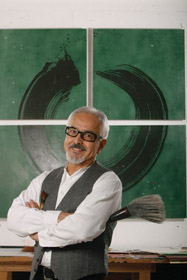 Across the alleyway (called Art Alley) from Marks’ studio and gallery is the working studio of artist Mario Uribe, a San Diego native who grew up in Baja and moved to Santa Rosa 20 years ago (and to SOFA in 2005). “I’ve been making art as long as I can remember,” he says.
Across the alleyway (called Art Alley) from Marks’ studio and gallery is the working studio of artist Mario Uribe, a San Diego native who grew up in Baja and moved to Santa Rosa 20 years ago (and to SOFA in 2005). “I’ve been making art as long as I can remember,” he says.
Uribe is inspired by Zen philosophy and traditional Japanese arts (you’ll see Zen circles in a lot of his work) and is best known for his public murals and sculptures (he did the murals along the Prince Memorial Greenway along with Artstart, an organization where he and his wife mentor and job train young, would-be artists). “Then the city wanted to do something at Prince Gateway Park, so I designed a sculpture based on a mural of a trout by a 16-year-old girl. “Guardian of the Creek” is the prominent, colorful, 13-by-6-foot sculpture of a trout breaking through concrete you can see there. He also did the Santa Rosa Veterans Memorial Monument. “I wanted it to be healing,” he says of the installation. The design is full of circles, and has veterans names permanently engraved into all but one of its pillars. “The last one is the prayer that we won’t be in the situation to have to add more names,” he says.
Uribe is currently involved in two new projects. One is a series of murals that say “Fear No Art,” with installations in Roseland, Art Alley and one at the Peace and Justice Center. “I hope to have 10 installed when I’m done,” he says. The second project is a series of murals in Roseland that will involve 12 artists and reflect what each part of the neighborhood is proud of. He also has a current art installation on display at Santa Rosa Golf and Country Club.
“Art is always good for business,” he says. “Sometimes cities don’t realize it. It takes some education. Since Santa Rosa is the hub of Sonoma County, it makes sense it should be the art capital of the county. Other towns make a bigger art statement. The city of Santa Rosa finally gets that art is important for business. Yes, people come for food and wine, but art, including events and festivals, brings even more people in from other areas.
“Artists usually care about their community and want to improve the quality of life. That’s my mission with the city. I really feel optimistic, because the city’s perspective is improving and so is our neighborhood. It’s all good,” says Uribe.
Business growth
The Spinster Sisters restaurant sits right in the heart of the district at the corner of South A Street and Sebastopol Road. Opened by co-owners Giovanni Cerrone (general manager), Eric Anderson and Chef Liza Hinman in 2012, it’s housed in a 1923 building that was originally an Italian market. Two sisters, both unmarried seamstresses, lived in apartments upstairs (thus the name).
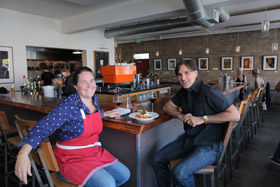 “We had a desire to see a change in Santa Rosa’s food scene,” says Cerrone. “We didn’t feel there was a restaurant like this [which serves seasonal, American comfort food with world cuisine inspiration], which is one that’s true to the spirit of discovery and surprise.
“We had a desire to see a change in Santa Rosa’s food scene,” says Cerrone. “We didn’t feel there was a restaurant like this [which serves seasonal, American comfort food with world cuisine inspiration], which is one that’s true to the spirit of discovery and surprise.
“We wanted an environment that wasn’t downtown,” he continues. “This area is all about art, so we thought it was a good place to be and that it could anchor the neighborhood by bringing in people. Now, we bring in 70,000 people annually, about 1,500 per week on average.”
The restaurant also serves as an art gallery, with exhibits that rotate every couple months and are introduced with opening receptions where guests can enjoy drinks and appetizers and meet the artists.
“Our art program is essential,” says Cerrone. “We’re a gallery that’s open all the time. The art is mostly local and is often booked a year in advance. We do it as a service to the community. This neighborhood is a destination for people wanting visual stimulation. It’s art for the senses.”
The restaurant seats 49, including a rectangular bar that seats 20. Even the wine list, curated by Cerrone, a native of Italy, is about discovery. “It’s not a showcase for just local wine. There are plenty of opportunities for that. We want to be eclectic and have wines that offer value from both here and around the world, because they fit the flavor profile of the food,” he says.
The Spinster Sisters’ popularity has grown greatly by word of mouth, positive online peer reviews and an uptick in Wine Country visitors. “Our guests are mostly local, but we’ve seen an increase in international tourists as well as people coming in via recommendations from hotels in San Francisco and local wineries,” says Cerrone. It’s also seen an increase in visibility through a partnership with Book Passage in Corte Madera. “About once per month, we host a best-selling author, usually chefs and travel personalities. They come in and present the book, and we have a multi-course dinner where people can meet the author and the menu is inspired by the book. It’s driven traffic from the entire Bay Area. It’s inspiring to see people from all over coming in.” The restaurant also supports the local community by giving back via events like Dining Out for Life and Dining Out for Humanity.
Its most recent project is to build Spinster Inn adjacent to the restaurant. “It wasn’t something we originally planned; it just makes sense,” says Cerrone. The inn will have nine spacious rooms on two levels, and half the bottom floor will be a pantry with food products, take out, wine and a large kitchen to better support the business’ catering services. “We’re in the process of getting permits and expect it will be finished next year. It will have a modern, industrial look—a reference to this area’s roots.
“We hope the inn will consolidate the idea of this neighborhood as a destination. People coming from outside will stimulate business creation. We’d like the neighborhood to be more vibrant and to add visibility. Our hope is to inspire other, similar businesses to open and to encourage walkability. We’d also like to see the neighborhood add more art beyond the visual, especially music. It will make it more active and dynamic,” he says.
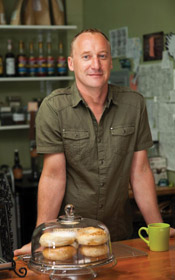 One place you can often find live music, aside from Chroma Gallery’s backyard, is Atlas Coffee. Owner James Podchernikoff took over the business in 2011.
One place you can often find live music, aside from Chroma Gallery’s backyard, is Atlas Coffee. Owner James Podchernikoff took over the business in 2011.
“I was working in education but needed a major change. I used to study here. I like the idea of it being in an arts district, where I can display art and have music.” The shop serves single-origin, drip coffee made from beans roasted by Linea Café in San Francisco. Each cup is freshly ground and made individually for customers. Podchernikoff also sells the direct trade beans (originating mostly from small farms from Ethiopia, Brazil and Guatemala).
Currently, Podchernikoff is working to expand the patio as well as the kitchen so it can serve more food, including freshly baked items, breakfast, smoothies, sandwiches and more. The work is scheduled to be completed this fall (maybe even before you read this). “We’ve always been a sort of punk rock coffee shop. Other shops are more sterile. I like a livelier environment,” he says. Aside from the shop, Podchernikoff is lead organizer and chairman for Winterblast. He’s also looking to make some new neighborhood events a reality.
Another newer business in the neighborhood is Criminal Baking Co. & Undercover Noshery, which has incredible baked desserts, breads, scones and more, as well as seasonal breakfast, quiche, panini and salads. Right near it is the space where The Imaginists’ performance laboratory is located. Founded by Brent Lindsay and Amy Pinto, the theater group does collaborative performances that bring communities together, pushing the boundaries of who performs, when and where. You can catch a free performance of “Calaveras del Monton” in Old Courthouse Square at 6:30 on November 1. They also host educational programs.
The Naked Pig opened in spring 2014, serving up only local, organic, seasonal fare for breakfast, lunch and weekend brunch. The creative, inspiring and delicious menu is as fun to choose from as it is to eat.
 In 2012, painter Molly Perez and jewelry maker Jaime Jean opened JaM JAr, a working art studio and retail space offering original works by the owners as well as other unique, different, one-of-a-kind gifts and other items, including some vintage pieces.
In 2012, painter Molly Perez and jewelry maker Jaime Jean opened JaM JAr, a working art studio and retail space offering original works by the owners as well as other unique, different, one-of-a-kind gifts and other items, including some vintage pieces.
“I’ve been working in the neighborhood for 10 years,” says Perez, who creates painting and collage (with recycled materials) on large wooden panels as well as smaller, framable works on paper. “Originally, I shared the space with another painter but, when she left, Jamie and I [who are long-time friends] were able to realize our dream of having a storefront. We knew there was interest in the area, but not much was open during regular business hours.”
Early on, the two discovered art was slow for sales, so they brought in items from people whose work they respected. “We’re ambassadors for local artisans and handmade products,” says Perez.
They also regularly work in the rear of the space during business hours. “People like to come in and see that,” says Jean, who’s been creating jewelry for more than 20 years out of semi-precious gemstones with sterling silver, brass and gold fill. “Our pieces compliment each other,” she adds. With their creative work and eclectic collection of items offered, they’ve certainly created a place where there’s something for everyone.
Ready to shine
The tiny Santa Rosa SOFA neighborhood is an ideal example of how a group of like-minded, artistic people can create experiences, open businesses and transform a once-forgotten area into one filled with newfound, growing and positive energy.
Winterblast
Winterblast, SOFA’s biggest event of the year, takes place November 14 from 5 p.m. to 9 p.m. This free, family-friendly event features open studios and gallery exhibits, live music, street performances and costumes, among other delights. Its centerpiece, so to speak, is the SOFA parade, which recurs every couple hours and features decorated sofas, music and more. This year, there are fire dancers scheduled to appear as well as the WhiskeyDrome, a wooden, angled, circular structure where bicyclists ride and perform stunts for onlookers (See “Making Tracks,” Oct. 2014) onsite. The streets are blocked off where the festivities take place, inviting shenanigans and a creative, spontaneous atmosphere to feed the soul. Businesses are encouraged to contact James Podchernikoff at Atlas Coffee to find out about sponsorship opportunities, become involved and get their name out to the community in the most fun way possible.
Get In Touch
Interested in learning more about the SOFA district, its events and businesses? Here’s contact information for the businesses and people mentioned in this article. There are many others in the area, so the neighborhood’s website (sofasantarosa.com) is the best place to start exploring—or just show up, walk around and enjoy yourself!
Atlas Coffee Company
(open daily until 5 p.m.)
facebook.com/atlascoffeecompany
Christie Marks Fine Art Gallery and Studio
Chroma Gallery
(Wed.-Sun. various daytime hours)
Criminal Baking Co. & Noshery
(open daily until 3 p.m.)
JaM JAr
(Wed.-Sat. 11 a.m.-5 p.m. or by appt.)
Mario Uribe
The Imaginists
The Naked Pig Cafe
(Wed.-Sun. 8 a.m.-3 p.m.)
facebook.com/pages/The-Naked-Pig-Cafe-farm-to-table-food/225071061027245
The Spinster Sisters
(Breakfast, lunch and dinner Tues.-Sun.; Breakfast and lunch Mondays)
Out of Area Artists Mentioned
Dan Bishop
Andrea Speer Hibbard
onethousandmonks@gmail.com
Laurence Glass Works
72 Main St., Occidental
(707) 874-3465


